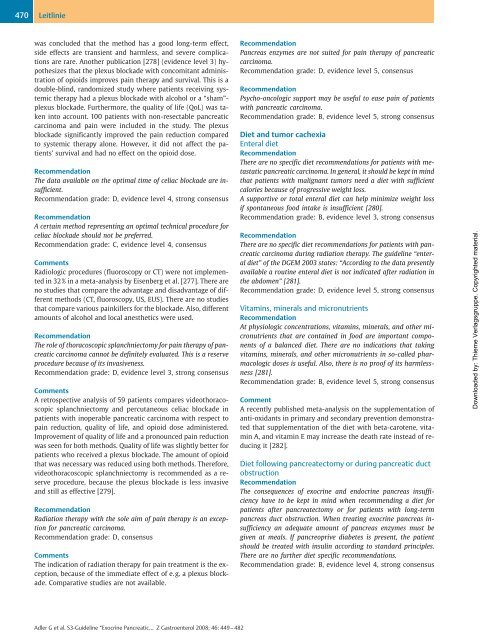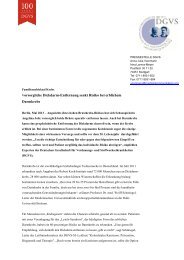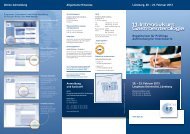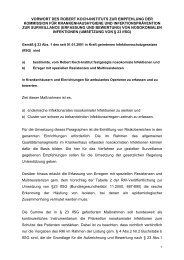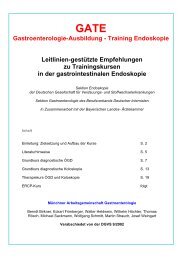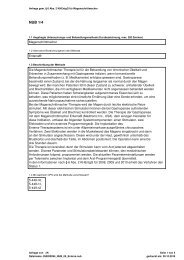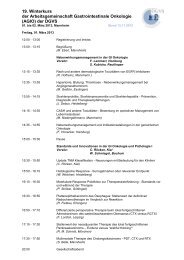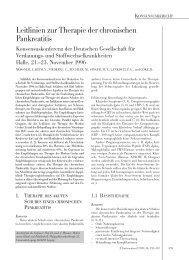S3-Guideline “Exocrine Pancreatic Carcinoma” 20071 ... - DGVS
S3-Guideline “Exocrine Pancreatic Carcinoma” 20071 ... - DGVS
S3-Guideline “Exocrine Pancreatic Carcinoma” 20071 ... - DGVS
Create successful ePaper yourself
Turn your PDF publications into a flip-book with our unique Google optimized e-Paper software.
470<br />
Leitlinie<br />
was concluded that the method has a good long-term effect,<br />
side effects are transient and harmless, and severe complications<br />
are rare. Another publication [278] (evidence level 3) hypothesizes<br />
that the plexus blockade with concomitant administration<br />
of opioids improves pain therapy and survival. This is a<br />
double-blind, randomized study where patients receiving systemic<br />
therapy had a plexus blockade with alcohol or a “sham”plexus<br />
blockade. Furthermore, the quality of life (QoL) was taken<br />
into account. 100 patients with non-resectable pancreatic<br />
carcinoma and pain were included in the study. The plexus<br />
blockade significantly improved the pain reduction compared<br />
to systemic therapy alone. However, it did not affect the patients’<br />
survival and had no effect on the opioid dose.<br />
Recommendation<br />
The data available on the optimal time of celiac blockade are insufficient.<br />
Recommendation grade: D, evidence level 4, strong consensus<br />
Recommendation<br />
A certain method representing an optimal technical procedure for<br />
celiac blockade should not be preferred.<br />
Recommendation grade: C, evidence level 4, consensus<br />
Comments<br />
Radiologic procedures (fluoroscopy or CT) were not implemented<br />
in 32% in a meta-analysis by Eisenberg et al. [277]. There are<br />
no studies that compare the advantage and disadvantage of different<br />
methods (CT, fluoroscopy, US, EUS). There are no studies<br />
that compare various painkillers for the blockade. Also, different<br />
amounts of alcohol and local anesthetics were used.<br />
Recommendation<br />
The role of thoracoscopic splanchniectomy for pain therapy of pancreatic<br />
carcinoma cannot be definitely evaluated. This is a reserve<br />
procedure because of its invasiveness.<br />
Recommendation grade: D, evidence level 3, strong consensus<br />
Comments<br />
A retrospective analysis of 59 patients compares videothoracoscopic<br />
splanchniectomy and percutaneous celiac blockade in<br />
patients with inoperable pancreatic carcinoma with respect to<br />
pain reduction, quality of life, and opioid dose administered.<br />
Improvement of quality of life and a pronounced pain reduction<br />
was seen for both methods. Quality of life was slightly better for<br />
patients who received a plexus blockade. The amount of opioid<br />
that was necessary was reduced using both methods. Therefore,<br />
videothoracoscopic splanchniectomy is recommended as a reserve<br />
procedure, because the plexus blockade is less invasive<br />
and still as effective [279].<br />
Recommendation<br />
Radiation therapy with the sole aim of pain therapy is an exception<br />
for pancreatic carcinoma.<br />
Recommendation grade: D, consensus<br />
Comments<br />
The indication of radiation therapy for pain treatment is the exception,<br />
because of the immediate effect of e.g. a plexus blockade.<br />
Comparative studies are not available.<br />
Adler G et al. <strong>S3</strong>-<strong>Guideline</strong> <strong>“Exocrine</strong> <strong>Pancreatic</strong>… Z Gastroenterol 2008; 46: 449–482<br />
Recommendation<br />
Pancreas enzymes are not suited for pain therapy of pancreatic<br />
carcinoma.<br />
Recommendation grade: D, evidence level 5, consensus<br />
Recommendation<br />
Psycho-oncologic support may be useful to ease pain of patients<br />
with pancreatic carcinoma.<br />
Recommendation grade: B, evidence level 5, strong consensus<br />
Diet and tumor cachexia<br />
Enteral diet<br />
Recommendation<br />
There are no specific diet recommendations for patients with metastatic<br />
pancreatic carcinoma. In general, it should be kept in mind<br />
that patients with malignant tumors need a diet with sufficient<br />
calories because of progressive weight loss.<br />
A supportive or total enteral diet can help minimize weight loss<br />
if spontaneous food intake is insufficient [280].<br />
Recommendation grade: B, evidence level 3, strong consensus<br />
Recommendation<br />
There are no specific diet recommendations for patients with pancreatic<br />
carcinoma during radiation therapy. The guideline “enteral<br />
diet” of the DGEM 2003 states: “According to the data presently<br />
available a routine enteral diet is not indicated after radiation in<br />
the abdomen” [281].<br />
Recommendation grade: D, evidence level 5, strong consensus<br />
Vitamins, minerals and micronutrients<br />
Recommendation<br />
At physiologic concentrations, vitamins, minerals, and other micronutrients<br />
that are contained in food are important components<br />
of a balanced diet. There are no indications that taking<br />
vitamins, minerals, and other micronutrients in so-called pharmacologic<br />
doses is useful. Also, there is no proof of its harmlessness<br />
[281].<br />
Recommendation grade: B, evidence level 5, strong consensus<br />
Comment<br />
A recently published meta-analysis on the supplementation of<br />
anti-oxidants in primary and secondary prevention demonstrated<br />
that supplementation of the diet with beta-carotene, vitamin<br />
A, and vitamin E may increase the death rate instead of reducing<br />
it [282].<br />
Diet following pancreatectomy or during pancreatic duct<br />
obstruction<br />
Recommendation<br />
The consequences of exocrine and endocrine pancreas insufficiency<br />
have to be kept in mind when recommending a diet for<br />
patients after pancreatectomy or for patients with long-term<br />
pancreas duct obstruction. When treating exocrine pancreas insufficiency<br />
an adequate amount of pancreas enzymes must be<br />
given at meals. If pancreoprive diabetes is present, the patient<br />
should be treated with insulin according to standard principles.<br />
There are no further diet specific recommendations.<br />
Recommendation grade: B, evidence level 4, strong consensus<br />
Downloaded by: Thieme Verlagsgruppe. Copyrighted material.


